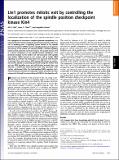| dc.contributor.author | Chan, Leon Y. | |
| dc.contributor.author | Falk, Jill | |
| dc.contributor.author | Amon, Angelika B | |
| dc.date.accessioned | 2012-04-25T21:06:02Z | |
| dc.date.available | 2012-04-25T21:06:02Z | |
| dc.date.issued | 2011-08 | |
| dc.date.submitted | 2011-04 | |
| dc.identifier.issn | 0027-8424 | |
| dc.identifier.issn | 1091-6490 | |
| dc.identifier.uri | http://hdl.handle.net/1721.1/70141 | |
| dc.description.abstract | For a daughter cell to receive a complete genomic complement, it is essential that the mitotic spindle be positioned accurately within the cell. In budding yeast, a signaling system known as the spindle position checkpoint (SPOC) monitors spindle position and regulates the activity of the mitotic exit network (MEN), a GTPase signaling pathway that promotes exit from mitosis. The protein kinase Kin4 is a central component of the spindle position checkpoint. Kin4 primarily localizes to the mother cell and associates with spindle pole bodies (SPBs) located in the mother cell to inhibit MEN signaling. In contrast, the kinase does not associate with the SPB in the bud. Thus, only when a MEN bearing SPB leaves the mother cell and the spindle is accurately positioned along the mother–bud axis can MEN signaling occur and cell division proceed. Here, we describe a mechanism ensuring that Kin4 only associates with mother cell-located SPBs. The bud-localized MEN regulator Lte1, whose molecular function has long been unclear, prevents Kin4 that escapes into the bud from associating with SPBs in the daughter cell. | en_US |
| dc.description.sponsorship | Howard Hughes Medical Institute | en_US |
| dc.description.sponsorship | National Science Foundation (U.S.) (Predoctoral Fellowship) | en_US |
| dc.description.sponsorship | National Institutes of Health (U.S.) (Grant GM056800) | en_US |
| dc.language.iso | en_US | |
| dc.publisher | National Academy of Sciences (U.S.) | en_US |
| dc.relation.isversionof | http://dx.doi.org/10.1073/pnas.1107784108 | en_US |
| dc.rights | Article is made available in accordance with the publisher's policy and may be subject to US copyright law. Please refer to the publisher's site for terms of use. | en_US |
| dc.source | PNAS | en_US |
| dc.title | Lte1 promotes mitotic exit by controlling the localization of the spindle position checkpoint kinase Kin4 | en_US |
| dc.type | Article | en_US |
| dc.identifier.citation | Falk, J. E., L. Y. Chan, and A. Amon. “Lte1 Promotes Mitotic Exit by Controlling the Localization of the Spindle Position Checkpoint Kinase Kin4.” Proceedings of the National Academy of Sciences 108.31 (2011): 12584–12590. Web. | en_US |
| dc.contributor.department | Massachusetts Institute of Technology. Department of Biological Engineering | en_US |
| dc.contributor.department | Koch Institute for Integrative Cancer Research at MIT | en_US |
| dc.contributor.approver | Amon, Angelika B. | |
| dc.contributor.mitauthor | Amon, Angelika B. | |
| dc.contributor.mitauthor | Falk, Jill E. | |
| dc.contributor.mitauthor | Chan, Leon Y. | |
| dc.relation.journal | Proceedings of the National Academy of Sciences of the United States of America | en_US |
| dc.eprint.version | Final published version | en_US |
| dc.type.uri | http://purl.org/eprint/type/JournalArticle | en_US |
| eprint.status | http://purl.org/eprint/status/PeerReviewed | en_US |
| dspace.orderedauthors | Falk, J. E.; Chan, L. Y.; Amon, A. | en |
| dc.identifier.orcid | https://orcid.org/0000-0003-2910-9803 | |
| dc.identifier.orcid | https://orcid.org/0000-0001-9837-0314 | |
| mit.license | PUBLISHER_POLICY | en_US |
| mit.metadata.status | Complete | |
